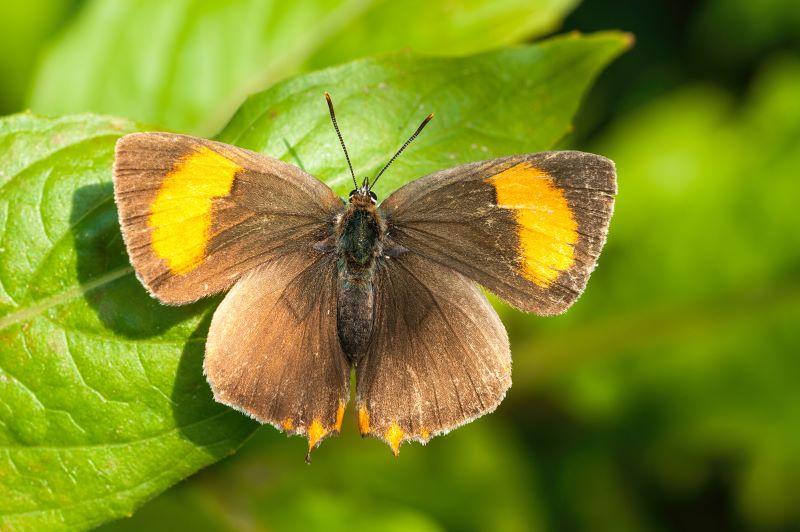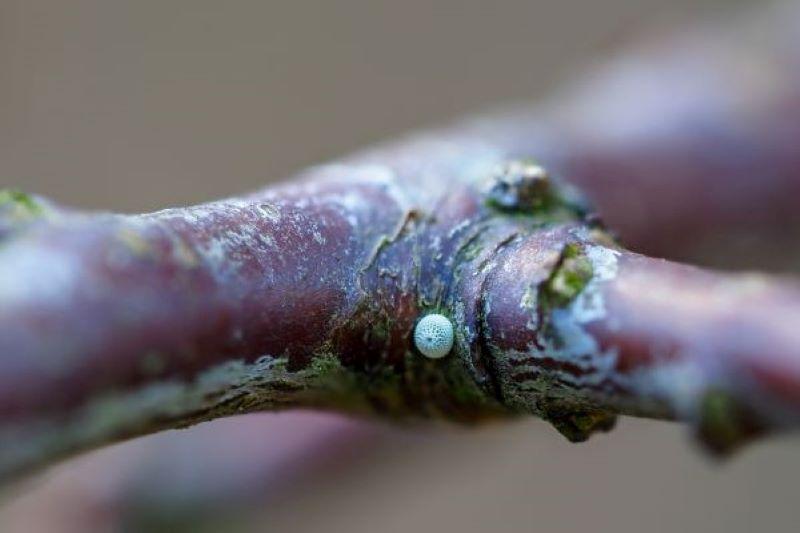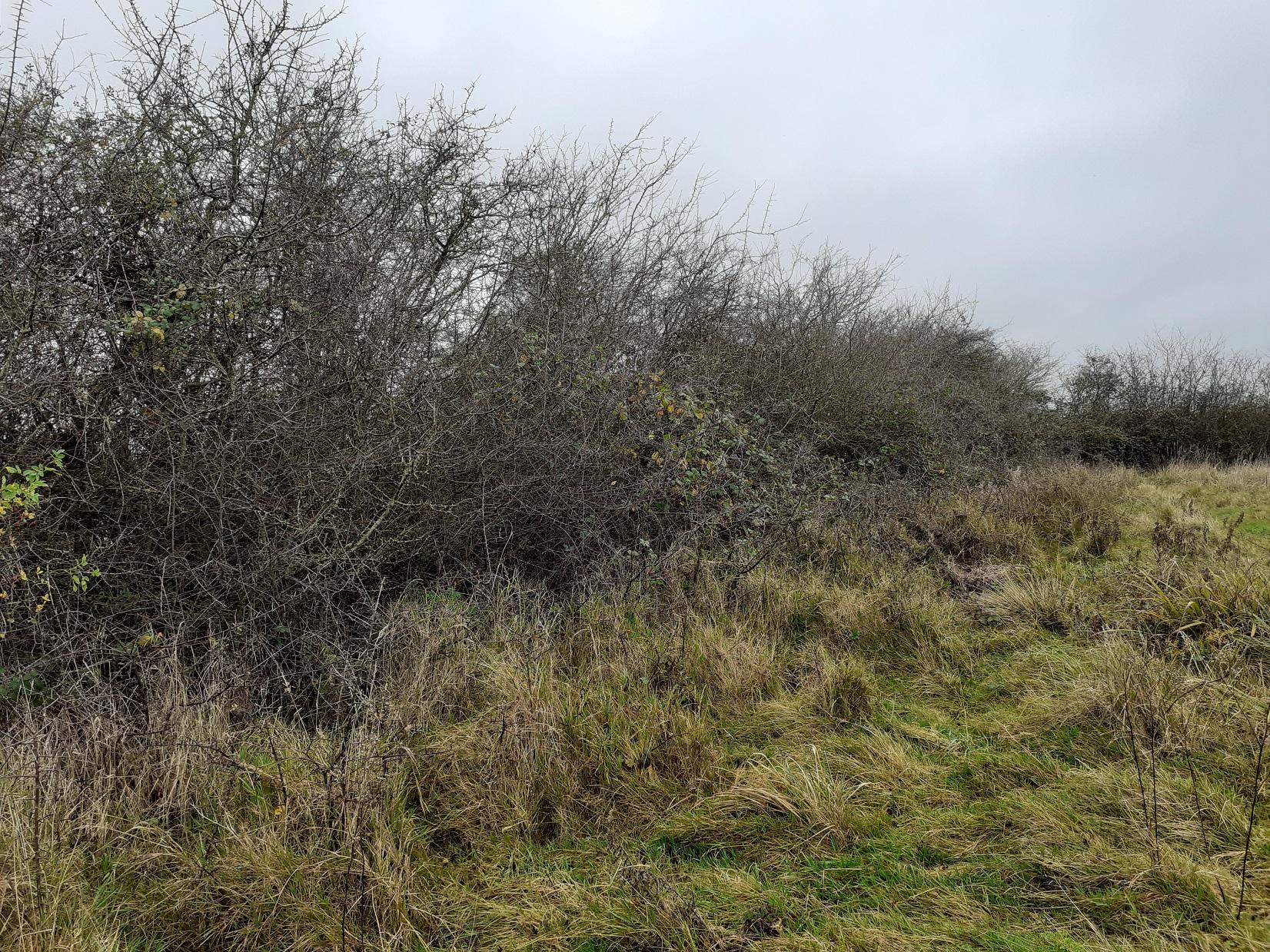
Brown hairstreaks and hedgerows
The brown hairstreak butterfly is categorised as a UK priority species due to its rarity and declining population. Thanks to the surveying and management of the hedgerows in the Heart of England Forest, its population is expanding here. Find out more from Sam, our Biodiversity Data and Survey Officer.
The brown hairstreak
The brown hairstreak is the largest of the five British hairstreaks and its name is somewhat deceiving; the upper wings are closer to amber in colour, with two white hair’s-breadth streaks crossing them (hence the name hairstreak!) and a small tail of vivid orange. The upper side is brown, although bordered with white and broken up with an orange splodge on each forewing.
The brown hairstreak’s lifecycle begins as an egg laid on blackthorn in August to October, normally between the stem and a thorn on young growth. When it hatches in April or May, the caterpillar munches through the blackthorn’s leaves, usually at night, and hides underneath the leaves from predators during the day.
Once fully grown around late-June, the caterpillar descends and forms a well-camouflaged chrysalis among the leaf litter and soil. It develops in this chrysalis through July before emerging as a butterfly in August. The butterflies congregate around ‘assembly trees’, usually ash, where they mate. Afterwards, the females spread out, lay their eggs, and continue this cycle.
Since the 1970s, the brown hairstreak has shown a decline in occurrence of almost 50%. More recently, this national decline in distribution appears to have been halted and may even be recovering. Despite this, the actual number of individual brown hairstreaks has continued to drop.

Brown hairstreaks in the Forest
In the local area, this butterfly had not been seen for over 70 years until it was rediscovered around Grafton Flyford in Worcestershire in 1970. Very little changed until the turn of the millennia, when Worcestershire’s brown hairstreak population went against national trends and began to rapidly spread. In 1994 it was found in just 16 1km squares but is now known in over in over 235 in Worcestershire!
This expanding population has now reached the Heart of England Forest. In 2018, the first brown hairstreak eggs were found around the Studley and Morton Bagot areas. Two eggs were seen once again at Morton Bagot last Autumn. The brown hairstreak has also been discovered at the Lenches in 2020, with the first sighting in the Forest of one of the elusive adults, a female, by a volunteer carrying out a butterfly survey. This was followed up by an egg found just a few hundred metres from where the butterfly was seen, and quite possibly laid by the same individual. We have recently found another 11 eggs nearby.
Management of hedgerows to benefit butterflies
But why is the brown hairstreak here in the Heart of England Forest? As mentioned previously, the butterfly lays its eggs on blackthorn. However, the brown hairstreak will only lay its eggs on blackthorn found in very specific conditions.
The blackthorn must be in a sheltered position from the wind and rain and on shoots between 2 – 5 years old which lack lichen and algae growth. A southern or eastern aspect is preferred, and hedges which are not flailed regularly and have many blackthorn suckers springing out of the ground next to them are also a huge benefit for the butterfly. The Forest is packed full of blackthorn hedgerows which fit just this description! The conditions present mean that this rare butterfly is likely to have a very good future here.
To ensure this, we carry out hedgerow suitability and egg surveys for brown hairstreak every winter. The eggs can be best described as golf balls the size of a pen nib. These may sound difficult to spot, but they stand out against the dark blackthorn stems, so are actually easier to find than the butterfly itself!
These surveys will be used to guide the management of our blackthorn hedgerows for the benefit of the brown hairstreak in the future, as well as judge how well the butterfly is doing in the Forest.

Spotting tips
Have a look along any hedgerows which match the description above and you may just find a brown hairstreak egg. Although we have currently only found them near Studley and Morton Bagot on the Warwickshire side of the Forest, they are quite possibly in other Forest hedgerows all the way down to Alcester.
Despite these butterflies being incredibly difficult to see, you may always have luck on your side. The butterfly pictured above, which appears to have had a run-in with a hungry bird, dropped right into my garden!

Butterflies in the Forest
The varied habitats found in the Forest attract many butterfly species. Volunteer and butterfly lover, Ramsay, shares the best places to spot them in his article.



